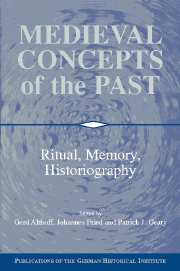Book contents
- Frontmatter
- Introduction
- 1 Authority and Legitimation of Royal Policy and Action: The Case of Henry II
- 2 King Henry II of Germany: Royal Self-Representation and Historical Memory
- 3 The Variability of Rituals in the Middle Ages
- 4 Rebels and Rituals: From Demonstrations of Enmity to Criminal Justice
- 5 Oblivion Between Orality and Textuality in the Tenth Century
- 6 Text and Ritual in Ninth-Century Political Culture: Rome, 864
- 7 The Concept of Time in the Historiography of the Eleventh and Twelfth Centuries
- 8 Constructing the Past by Means of the Present: Historiographical Foundations of Medieval Institutions, Dynasties, Peoples, and Communities
- 9 Topographies of Memory: Center and Periphery in High Medieval France
- 10 Challenging the Culture of Memoria: Dead Men, Oblivion, and the “Faithless Widow” in the Middle Ages
- 11 Artistic and Literary Representations of Family Consciousness
- 12 The Strange Pilgrimage of Odo of Deuil
- 13 The Rhineland Massacres of Jews in the First Crusade: Memories Medieval and Modern
- 14 The Martyr, the Tomb, and the Matron: Constructing the (Masculine) “Past” as a Female Power Base
- Index
13 - The Rhineland Massacres of Jews in the First Crusade: Memories Medieval and Modern
Published online by Cambridge University Press: 05 January 2013
- Frontmatter
- Introduction
- 1 Authority and Legitimation of Royal Policy and Action: The Case of Henry II
- 2 King Henry II of Germany: Royal Self-Representation and Historical Memory
- 3 The Variability of Rituals in the Middle Ages
- 4 Rebels and Rituals: From Demonstrations of Enmity to Criminal Justice
- 5 Oblivion Between Orality and Textuality in the Tenth Century
- 6 Text and Ritual in Ninth-Century Political Culture: Rome, 864
- 7 The Concept of Time in the Historiography of the Eleventh and Twelfth Centuries
- 8 Constructing the Past by Means of the Present: Historiographical Foundations of Medieval Institutions, Dynasties, Peoples, and Communities
- 9 Topographies of Memory: Center and Periphery in High Medieval France
- 10 Challenging the Culture of Memoria: Dead Men, Oblivion, and the “Faithless Widow” in the Middle Ages
- 11 Artistic and Literary Representations of Family Consciousness
- 12 The Strange Pilgrimage of Odo of Deuil
- 13 The Rhineland Massacres of Jews in the First Crusade: Memories Medieval and Modern
- 14 The Martyr, the Tomb, and the Matron: Constructing the (Masculine) “Past” as a Female Power Base
- Index
Summary
Nine hundred years ago, crusaders passing through the Rhineland on their way to Jerusalem attacked Jews in towns throughout the region surrounding Heidelberg. Many Jews were killed or converted to Christianity, and many took their own lives in order to avoid baptism. The events themselves occupy a significant place in modern Jewish historiography and are often presented as the first instance of an anti-Semitism that would henceforth never be forgotten and whose climax was the Holocaust. As Arno Mayer put it in his study of the “Final Solution”: “The attack on the Jews [in 1096] set a disastrous precedent, depositing a fatal poison in the European psyche and imagination.” Moreover, some have seen the texts that a number of Jewish communities produced in the aftermath of the massacres as the vessels of a collective memory that gave Jews strength and allowed them to retain their identity throughout a history of tragedies; a collective memory that, in Alan Mintz's words, “summed up [for modern Jews] the past to be espoused or rejected.” The First Crusade massacres emerge in such scholarship as a focal point in a narrative of Jewish history that asserts the identity of past and present suffering, and that finds its coherence in a teleology of escalating persecution leading to the Holocaust and to Zionist redemption.
- Type
- Chapter
- Information
- Medieval Concepts of the PastRitual, Memory, Historiography, pp. 279 - 310Publisher: Cambridge University PressPrint publication year: 2002
- 1
- Cited by

